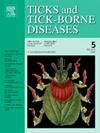西班牙Aragón地区羊无原体感染流行病学研究
IF 3.4
2区 医学
Q2 INFECTIOUS DISEASES
引用次数: 0
摘要
绵羊无形体病是欧洲的一种新发疾病,主要影响地中海地区。它是由鹅无原体引起的,一种主要由蜱虫传播的细菌。尽管它的存在越来越多,但有关其在欧洲分布的全面数据仍然很少。本流行病学研究旨在评估2023年3月至2024年4月期间西班牙Aragón地区绵羊养殖场的羊链球菌流行情况。总共有70个农场,覆盖了Aragón不同的气候带,代表了700只羊。使用定量PCR (qPCR)检测了两个汇集的血液样本,每个农场包括5只羊,以检测山羊单胞杆菌的存在。结果显示这种细菌广泛存在,70个农场中有69个检测呈阳性。唯一的阴性案例是位于萨拉戈萨附近干燥草原气候区的一个农场,海拔约240米。值得注意的是,在研究期间,没有任何动物出现这种疾病的临床症状。除了发病率高外,该研究还强调了农民对该病缺乏认识的问题,只有33%的农民报告熟悉该病。这些发现强调了在Aragón的广泛分布,并表明气候条件和牲畜管理方法对传播都没有显著影响。该研究还强调,迫切需要加强控制措施,加强农民教育,并进一步研究可能导致疫情的环境和管理因素。本文章由计算机程序翻译,如有差异,请以英文原文为准。
Epidemiological study on the prevalence of Anaplasma ovis infection in Aragón, Spain
Ovine anaplasmosis is an emerging disease in Europe, primarily affecting the Mediterranean region. It is caused by Anaplasma ovis, a bacterium mainly transmitted by ticks. Despite its growing presence, comprehensive data on its distribution across Europe remain scarce. This epidemiological study aimed to assess the prevalence of A. ovis in sheep farms across Aragón, Spain, between March 2023 and April 2024. A total of 70 farms, covering a diverse range of climatic zones within Aragón, were sampled, representing 700 sheep. Two pooled blood samples, each comprising five sheep per farm, were tested using quantitative PCR (qPCR) to detect the presence of A. ovis. The results revealed a widespread presence of the bacterium, with 69 out of 70 farms testing positive. The only negative case was a farm located in a Steppe Dry climate area near Zaragoza, at approximately 240 m above sea level. Notably, no clinical signs of the disease were observed in any of the animals during the study period. In addition to the high prevalence, the study highlighted a concerning lack of awareness among farmers, with only 33 % reporting familiarity with the disease. These findings underscore the extensive distribution of A. ovis in Aragón and suggest that neither climatic conditions nor livestock management practices had a significant influence on transmission. The study also emphasizes the urgent need for enhanced control measures, increased farmer education, and further research into environmental and management factors that may contribute to outbreaks.
求助全文
通过发布文献求助,成功后即可免费获取论文全文。
去求助
来源期刊

Ticks and Tick-borne Diseases
INFECTIOUS DISEASES-MICROBIOLOGY
CiteScore
6.90
自引率
12.50%
发文量
185
审稿时长
6-12 weeks
期刊介绍:
Ticks and Tick-borne Diseases is an international, peer-reviewed scientific journal. It publishes original research papers, short communications, state-of-the-art mini-reviews, letters to the editor, clinical-case studies, announcements of pertinent international meetings, and editorials.
The journal covers a broad spectrum and brings together various disciplines, for example, zoology, microbiology, molecular biology, genetics, mathematical modelling, veterinary and human medicine. Multidisciplinary approaches and the use of conventional and novel methods/methodologies (in the field and in the laboratory) are crucial for deeper understanding of the natural processes and human behaviour/activities that result in human or animal diseases and in economic effects of ticks and tick-borne pathogens. Such understanding is essential for management of tick populations and tick-borne diseases in an effective and environmentally acceptable manner.
 求助内容:
求助内容: 应助结果提醒方式:
应助结果提醒方式:


